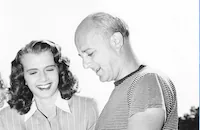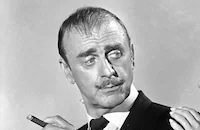Last of the Buccaneers

Brief Synopsis
Cast & Crew
Lew Landers
Paul Henreid
Jack Oakie
Karin Booth
Mary Anderson
Edgar Barrier
Film Details
Technical Specs

Synopsis
During the War of 1812, pirate Jean Lafitte helps General "Stonewall" Jackson defeat the British and endears himself to Belle Summers, the beautiful niece of wealthy shipowner George Mareval. Later, when the governor of Louisiana refuses to return his ships to him, Lafitte captures a recently provisioned ship belonging to Mareval. He then offers his services to the consul of Venezuela, whose country is at war with Spain. Knowing that as long as he loots only Spanish ships, the American authorities will leave him alone, Lafitte promises to return for Belle and takes to the seas. As the months pass, Lafitte and his buccaneers establish a kingdom on the island of Galveston in the Gulf, and Lafitte builds a castle, which he names the Maison Rouge. The spoils from his raids are kept in tunnels which, if threatened, can be destroyed by a pulling a secret lever. When pirate Cragg Brown attacks an American ship against Lafitte's express orders, he is hanged. In New Orleans, the news that one of Lafitte's ships has plundered an American vessel angers the people. Belle is convinced that Lafitte is innocent and offers to prove it. Under safe conduct from the authorities, Lafitte takes Belle to Galveston, where she plans to prove that the bills of lading for the goods in his warehouse do not correspond with those from the missing American ship. Shortly before her wedding day, however, Belle finds a document that proves that Lafitte does have the loot from the American ship. Not knowing that Lafitte has hanged the responsible man, she gives the authorities in New Orleans information that will enable them to capture Galveston. Just before the soldiers arrive, Belle learns the truth about the capture of the ship, but it is too late to stop the invasion. When the soldiers are about to search the tunnel, Swallow, the daughter of one of Lafitte's loyal workers, pulls the secret lever, and the treasure is buried forever. Lafitte forgives Belle, and the two lovers escape in a fishing boat.

Director

Lew Landers
Cast

Paul Henreid

Jack Oakie
Karin Booth

Mary Anderson
Edgar Barrier

John Dehner

Harry Cording
Eugene Borden
Jean Del Val

Pierre Watkin
Sumner Getchell
Paul Marion
Rusty Wescoatt
Crew
Mischa Bakaleinikoff
Henry Batista
Sidney Clifford
Jack Corrick
Francis Cugat
Vincent Farrar
Sam Katzman
Robert E. Kent
Herbert Leonard
Paul Palmentola
Josh Westmoreland

Film Details
Technical Specs

Articles
Last of the Buccaneers
Among the first to recant his Committee affiliation was Bogart, then pushing fifty and fearful of the deleterious effect of scandal on his career. (Though not part of the Committee, Hollywood liberals John Garfield and Edward G. Robinson would, also under pressure from HUAC, take a tip from Bogie and proclaim publically to have been duped by the Reds.) Unwilling to retract his assertion that no one should be coerced into declaring political allegiance by government fiat, Henreid was blacklisted as a purported Communist sympathizer- though it took him a year to learn that he had been barred from studio employment. (Henreid was also named by friendly HUAC witness Adolphe Menjou as "an associate" of Hollywood union leader Herbert Sorrell, a suspected party member.) Unlike his fellows on the Committee, who were represented and protected by their studios, Henreid had gone independent, breaking his Warner Brothers contract to star in Song of Love (1947) at MGM and the Eagle Lion release Hollow Triumph (1948). Back in Hollywood, no offers of work were forthcoming and a proposed TV series in which Henreid was to star for producer Desi Arnaz evaporated. Concerned friends in the industry, led by director William Dieterle, wrangled Henreid a supporting role in the desert actioner Rope of Sand (1949) but after that the actor was on his own.
Henreid's salvation was the European market, in which he remained a viable commercial entity. After completing the independently-produced social drama So Young So Bad (1950) in New York, Henreid traveled abroad to take the lead in the comedy Pardon My French (1951) and make two films for Hammer Film Productions -- Stolen Face (1952) and Man in Hiding (1953), both directed by Terence Fisher. During this time, Henreid also entered into a profit-sharing arrangement with Columbia Pictures, via independent producer Sam Katzman, starring in the swashbuckler Last of the Buccaneers (1950). Because Katzman operated outside of the studio prevue (albeit using its resources), Henreid was able to evade the blacklist. Though his salary was a fraction of what it had been only a year earlier, his share in the profits made the gamble pay off handsomely. Receipts were so good for Last of the Buccaneers that studio president Harry Cohn attempted to weasel out of the profit-sharing deal by offering Henreid a flat payment. When Henreid and his agent, Ingo Preminger, refused to renegotiate, Cohn simply signed the actor up for more of the same - a starring role in Pirates of Tripoli (1955).
Henreid's native suavity made him a natural to play Jean Lafitte, the French privateer who came to America's aid during the 1814 Battle of New Orleans. Clearly corrupt but undeniably courageous, Lafitte inspired Lord Byron's "The Corsair" and was the hero of Rupert Julian's silent swashbuckler The Millionaire Pirate (1919). Lafitte was the focus as well of Cecil B. DeMille's The Buccaneer (1938) - whose star, Fredric March, had traveled from New York to join the Committee for the First Amendment in October 1947 and, like Henreid, was blacklisted for his troubles. Cast in a supporting role in Last of the Buccaneers was veteran character actor John Dehner, who went on to have his own crack at playing Lafitte (or someone claiming to be him) in the 1964 Bonanza episode "The Gentleman from New Orleans." For Paul Henreid, the blacklist endured for five years. His star wattage having dimmed by 1952, he turned to directing, helming episodes of such popular series as Maverick, Alfred Hitchcock Presents, and The Big Valley, while contributing cameos to such films as Operation Crossbow (1965) and Exorcist II: The Heretic (1977).
By Richard Harland Smith
Sources: Ladies Man: An Autobiography by Paul Henreid, with Julius Fast (St. Martin's Press, 1984)
Bogart by A. M. Sperber and Eric Lax (William Morrow and Company, 1997)
Hollywood's Blacklists: A Political and Cultural History by Reynold Humphries (Edinburgh University Press, 2010)

Last of the Buccaneers
Quotes
Trivia
Notes
Jean Lafitte was a French pirate who headed a band of privateers and smugglers outside New Orleans, LA, and was also involved in the slave trade. During the War of 1812, when the British asked for his help in an attack on New Orleans, he revealed their plans to the American authorities. During the Battle of New Orleans in late 1814, Lafitte was put in charge of American artillery. After the end of the war, Lafitte returned to piracy and established his headquarters at Galveston, TX. His headquarters were raided and destroyed after he scuttled an American merchant ship in 1820. He continued his pirate raids on the Spanish high seas until he disappeared around 1825. Lafitte was also the main character in two Cecil B. De Mille films, both called The Buccaneer. The 1938 Paramount film starred Fredric March as the pirate (see AFI Catalog of Feature Films, 1931-40; F3.0518) in the 1958 film, the role was performed by Yul Brynner.














